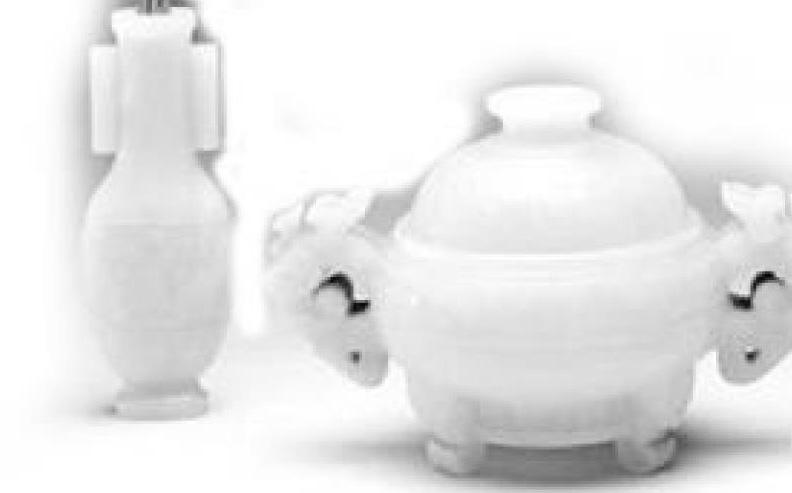Jade:A romance of the stone
2020-05-25


Some 8,000 years ago, Chinese ancestors living in todays north China started to make earrings and necklaces out of a kind of stone in colors of light green or creamy white. The stone has been attached with deep connotations ever since. It embodies the Confucian virtues of wisdom, justice and modesty. It bears the supreme ideals of Chinese culture. It bridges the distance between heaven and human beings. It is the symbol of auspice, power and wealth. The great-grandfather of Emperor Qin Shihuang, the founder of Qin Dynasty (221 to 207 BC), once offered to trade 15 cities for a single piece of the stone.
In ancient China, people viewed jade as a spiritual medium through which they could communicate with and be blessed by gods. Even today, Chinese still maintain the habit of wearing jade pendants of Kwan-yin or Buddhist figures as talismans. Jade ornaments are popular presents among friends and relatives: longevity peaches for elders, love locks for young couples.
As the jade pendant touches ones skin when worn, it is believed that jade and the person who wears it nourish each other, as the skin absorbs the microelements of the jade, which balances the yin and yang of the human body. Since the Jin Dynasty (265 -420 AD), jade powder has been an important ingredient in traditional Chinese medicine. Yu, the Chinese character for jade, has always been a favorable name as it represents purity and elegance. Similarly, Chinese idioms and phrases that involve yu usually communicate a sense of a woman being beautiful, or a man being righteous and loyal. For instance, a man unwilling to make a compromise could say that he prefers to “break as jade, rather than remain safe as tile.”
With the “Chinese Seal, Dancing Beijing,” the Beijing 2008 Olympic emblem carved out of Hotan jade, Chinese people extend their blessings to the entire world.
Like gold or diamonds in the west, jade in China symbolizes the highest aesthetic and moral excellence. It was Confucius who first compared the mildness and purity of jade to mans properties of benevolence, good faith and intelligence. Hence a gentleman or a scholar would always have jade on his person, as proof that he was trustworthy and respectable. Because of its extraordinary toughness, jade was also associated with immortality, which then extended to religious images of heaven.
Jade ware used in rituals was also a symbol of political rank. In the spring and autumn period, six types of jade ware were used for officials at six different ranks: the scale of the jade ware decreased as the ranks lowered.
Jade in the Royal Palace
The Forbidden City houses what might be some of the rarest treasures and curiosities in the world.
Serving as both daily appliances and decorations, jade wares can be found almost everywhere inside the palace, accounting for more than 80 percent of all the art works on display.
Currently, the palace museum boasts a collection of 30,311 pieces of jade ware, among which more than 20,000 are from the Qing Dynasty and 5,000 from the Ming Dynasty. The collection covers the period from Neolithic Age through the late Qing Dynasty, adding up to more than 7,000 years.
One of the jade wares worth mentioning here is a large sculpture commissioned for Qianlongs 80th birthday. Entitled “Jade Mountain Showing the Great Yu Taming the Flood,” the masterpiece stands 2.4 meters high and about 1 meter wide, and weighs more than 5 tons. According to historical records, it took about three years to move the jade stone down from Mount Mileta in the Hotan area, Xinjiang. Another three years passed in transporting the stone over a distance of 4,000 kilometers to Beijing. The stone was then sent to Yangzhou to be carved and polished. On the whole, more than 10 years elapsed and a countless amount of money was paid before it finally became the national treasure that it is now.
Jade among the Common Folk
Before the Sui Dynasty (581-618 AD), jade was exclusively for royals and aristocrats. The Song
Dynasty (960-1279 AD) saw the prevalence of jade markets. Common people began to develop a closer relationship with jade. Such a relationship did not end at ones death: if included in the funeral objects, jade would safeguard ones soul to heaven.
Ancient Chinese believed that the soul continued to live in the tomb after ones death, on the condition that the remains were well preserved. They tried every means to protect the body from rotting, and believed that jade had special effects in this regard.
